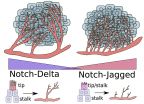(Press-News.org) Cancer cells defy the rules by which normal cells abide. They can divide without cease, invade distant tissues and consume glucose at abnormal rates.
Now a study by University of Pennsylvania researchers implicates defects in mitochondria, the energy-production centers of cells, as playing a key role in the transition from normal to cancerous. When the Penn scientists disrupted a key component of mitochondria, otherwise normal cells took on characteristics of cancerous tumor cells.
The research is published in the journal Oncogene and was led by members of the lab of Narayan G. Avadhani, the Harriet Ellison Woodward Professor of Biochemistry in Penn's School of Veterinary Medicine's Department of Biomedical Sciences, in collaboration with the lab of Hiroshi Nakagawa from the Gastroenterology Division in Penn's Perelman School of Medicine. Satish Srinivasan, a research investigator in Avadhani's lab, was the lead author. Manti Guha, Dawei Dong and Gordon Ruthel of Penn Vet and Kelly A. Whelan of Penn Medicine also contributed, along with Yasuto Uchikado and Shoji Natsugoe of Japan's Kagoshima University.
In 1924, German biologist Otto Heinrich Warburg observed that cancerous cells consumed glucose at a higher rate than normal cells and had defects in their "grana," the organelles that are now known as mitochondria. He postulated that the mitochondrial defects led to problems in the process by which the cell produces energy, called oxidative phosphorylation, and that these defects contributed to the cells becoming cancerous.
"The first part of the Warburg hypothesis has held up solidly in that most proliferating tumors show high dependence on glucose as an energy source and they release large amounts of lactic acid," Avadhani said. "But the second part, about the defective mitochondrial function causing cells to be tumorigenic, has been highly contentious."
To see whether the second part of Warburg's postulation was correct, the Penn-led research team took cell lines from the skeleton, kidney, breast and esophagus and used RNA molecules to silence the expression of select components of the mitochondrias' cytochrome oxidase C, or CcO, a critical enzyme involved in oxidative phosphorylation. CcO uses oxygen to make water and set up a transmembrane potential that is used to synthesize ATP, the molecule used for energy by the body's cells.
The biologists observed that disrupting only a single protein subunit of cytochrome oxidase C led to major changes in the mitochondria and in the cells themselves.
"These cells showed all the characteristics of cancer cells," Avadhani said.
They displayed changes in their metabolism, becoming more reliant on glucose and reducing their synthesis of ATP. Instead of conducting oxidative phosphorylation, they largely switched over to conducting glycolysis, a less efficient means of making ATP that is common in cancer cells.
The cells lost contact inhibition and gained an increased ability to invade distant tissues, both "hallmarks of cancer cells," Avadhani noted. When they were grown in a 3D medium, which closely mimics the natural environment in which tumors grow in the body, the cells with disrupted mitochondria formed large, long-lived colonies, akin to tumors.
The researchers also silenced cytochrome oxidase C subunits in an already-tumorigenic breast and esophageal cancer cell lines.
"We found that the cells became even more invasive, heightening their malignant potency," Srinivasan said.
Finally the Penn team looked at actual tumors from human patients and found that the most oxygen-starved regions, which are common in tumors, contained defective versions of cytochrome oxidase.
"That result alone couldn't tell us whether that was the cause or effect of tumors, but our cell system clearly says that mitochondrial dysfunction is a driving force in tumorigenesis," Avadhani said.
The researchers observed that disrupting CcO triggered the mitochondria to activate a stress signal to the nucleus, akin to an "SOS" alerting the cell that something is amiss. Avadhani and his colleagues had previously seen a similar pathway activated in cells with depleted mitochondrial DNA, which is also linked to cancer.
Building on these findings, Avadhani and members of his lab will examine whether inhibiting components of this mitochondrial stress signaling pathway might be a strategy for preventing cancer progression.
"We are targeting the signaling pathway, developing a lot of small molecules and antibodies," Avadhani said. "Hopefully if you block the signaling the cells will not go into the so called oncogenic mode and instead would simply die."
In addition, they noted that looking for defects in cytochrome oxidase C could be a biomarker for cancer screening.
INFORMATION:
The work was supported by the National Institutes of Health and Harriet Ellison Woodward Trust.
Boulder, Colo., USA - Submarine landslides, also known as mass transport deposits (MTDs), are common in marine environments and pose risks to coastal communities and offshore infrastructure. This new 332-point database presented by Lorena Moscardelli and Lesli Wood is drawn from studies of multiple MTDs around the world. Understanding these MTDS, they write, will help determine the extent of ancient submarine landslides and contribute to the development geo-models for forecasting future submarine slides.
FEATURED ARTICLE
Morphometry of mass transport deposits as a predictive ...
WASHINGTON, D.C. - Southern Californians and writers love to blame the hot, dry Santa Ana winds for tense, ugly moods, and the winds have long been associated with destructive wildfires.
Now, a new study finds that on occasion, the winds have an accomplice with respect to fires, at least: Natural atmospheric events known as stratospheric intrusions, which bring extremely dry air from the upper atmosphere down to the surface, adding to the fire danger effects of the Santa Anas, and exacerbating some air pollution episodes.
The findings suggest that forecast models with ...
AROUND half of all breast cancer patients could one day benefit from having the cheap and widely-available female hormone progesterone added to their treatment, according to Cancer Research UK funded research published in Nature today (Thursday)*.
Tumours fuelled by the female hormone oestrogen are treated with drugs like tamoxifen to block oestrogen receptors, which cause cancer cells to grow.
Women whose tumours have progesterone receptors as well are known to have a better outlook. But for decades scientists have been unable to pinpoint why.
Scientists at Cancer ...
From a Glacier's Perspective
Big Four glacier & ice caves, WA: a short future?
Early summer melting led to the collapse of Washington ice caves, the death of one person, and the injury of five others. Mauri Pelto asks questions about the future of Washington's Big Four glacier on his blog From a Glacier's Perspective.
Eos.org
Learning geoscience by doing geoscience
A pilot project helps teachers bring scientific practice into the classroom.
New research papers
Response of the Amazon carbon balance to the 2010 drought derived with CarbonTracker South America, ...
Researchers have developed a new approach for better integrating medical devices with biological systems. The researchers, led by Bozhi Tian, assistant professor in chemistry at the University of Chicago, have developed the first skeleton-like silicon spicules ever prepared via chemical processes.
"Using bone formation as a guide, the Tian group has developed a synthetic material from silicon that shows potential for improving interaction between soft tissue and hard materials," said Joe Akkara, a program director in the National Science Foundation materials research ...
Tropical Depression 4E formed in the Eastern Pacific and crossed the 140 West longitude line as of the 0300 UTC time, which brought it into the Central Pacific Ocean. NOAA's GOES-West satellite captured an infrared image of the depression at 0900 UTC (5 a.m. EDT) on July 8 that showed the large storm in the Central Pacific.
At 8 p.m. PDT/11 p.m. EDT on July 7, (0300 UTC on July 8), the center of newly formed Tropical Depression Four-E was located near latitude 15.4 North, longitude 140.2 West. The depression was moving toward the west-northwest near 17 mph (28 kph) and ...
Rice University researchers have built a simulation to show how cancerous tumors manipulate blood-vessel growth for their own benefit.
Like all cells, those in tumors need access to the body's fine network of blood vessels to bring them oxygen and carry away waste. Tumors have learned to game the process called angiogenesis in which new vessels sprout from existing ones, like branches from a tree.
But some details have been hidden until now.
The ability to stop tumors through anti-angiogenesis is one goal of cancer therapy. The new work by scientists at Rice's Center ...
July 8, 2015 - A recent CDC report calls into question the widely reported belief that Black fathers are more absent in their children's lives than White fathers - showing that while more Black fathers live apart from their children, they are just as involved with their children as members of other racial groups in the same living situations. So why is it that messages about Black absentee fathers, such as Obama's 2008 Father's Day address, are so pervasive in society?
A new paper, published today in Social Psychological and Personality Science, suggests that such messages ...
CAMBRIDGE, Mass--When you spill a bit of water onto a tabletop, the puddle spreads -- and then stops, leaving a well-defined area of water with a sharp boundary.
There's just one problem: The formulas scientists use to describe such a fluid flow say that the water should just keep spreading endlessly. Everyone knows that's not the case -- but why?
This mystery has now been solved by researchers at MIT -- and while this phenomenon might seem trivial, the finding's ramifications could be significant: Understanding such flowing fluids is essential for processes from the ...
CHICAGO (July 8, 2015): Work hour restrictions for resident physicians, revised nationally four years ago largely to protect patients against physician trainees' fatigue-related errors, have not had the desired effect of lowering postoperative complication rates in several common surgical specialties, according to new study results. The study was published as an "article in press" on the Journal of the American College of Surgeons website in advance of print publication later this year.
There was no significant difference in measured surgical patient outcomes between ...


